752 THE LONG REACHOF THE LONGDOG
THE LONG REACH OF THE LONGDOG
by David Hancock
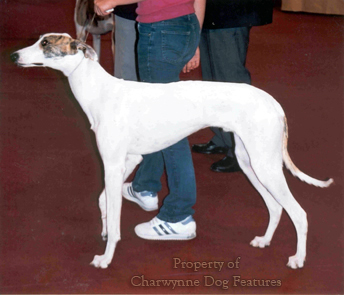 “A longdog is a hybrid between two sighthounds, between two dogs of similar type, both bred essentially for speed but also specifically ‘tailored’ for a particular task…Lurchers were bred as all-purpose hunting dogs and are the result of ameliorating purebred sighthounds with the blood of other breeds, breeds other than sighthounds, that is – namely collies, Bedlington Terriers, and occasionally, gun dog breeds.”
“A longdog is a hybrid between two sighthounds, between two dogs of similar type, both bred essentially for speed but also specifically ‘tailored’ for a particular task…Lurchers were bred as all-purpose hunting dogs and are the result of ameliorating purebred sighthounds with the blood of other breeds, breeds other than sighthounds, that is – namely collies, Bedlington Terriers, and occasionally, gun dog breeds.”
Brian Plummer, writing in his The Complete Book of Sight Hounds, Long Dogs and Lurchers, Robinson Publishing, 1991.
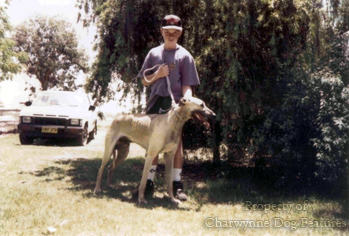
It could be argued that of all types of sporting dog the longdog has the longest reach, featuring from the American prairies to the Asiatic steppes and from Northern Europe to Central Africa. You may not find them in the densely wooded areas of Scandinavia or South America, but where there are open spaces, and especially where deer abound you will find the canine speedsters. As human settlements change their nature and urban living increases remorselessly, we may gradually lose them as the demise of such types as the Mahratta Hound of India and the Circassian Hound of the steppes indicate, but the Rampur Hound of India, the Chart Polski and Magyar Agar of Eastern Europe still have their devotees. Colonists too introduced longdogs to North America and Australia, where they quickly adjusted to quite different quarry..jpg)
The longdog function in the United States was first carried out there by what they call staghounds, big rough-haired hunting dogs, crossbred in pursuit of function not whim, although hunters’ preferences do manifest themselves in their anatomies. In his Hunting Dogs of 1909, (Harding Publishing Co of Columbus, Ohio) Oliver Hartley refers to a Minnesota wolfer who averaged 35 wolves a year and who pinned his faith in the long-eared variety of hounds, with features of strength, endurance, good tonguers and stayers. He had been advised that the best dogs for coyotes, were part English blue (i.e.Greyhounds,) and Russian stag (i.e.Borzois,). He wrote that the English blue are very fast and the stag are long-winded, with the grit to make a good fight. He wrote that another admired and capable dog is the one-half Scotch stag hound (i.e. Scottish Deerhound,) and one-half Greyhound. He recorded that a Wisconsin hunter believed that the best breed for catching and killing coyotes is made by one-half shepherd (our working collie) and one-half hound, bei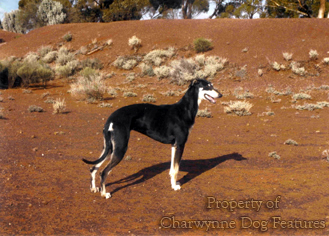 ng quicker than a hound and trailing just as well on a hot trail. He wrote too that another fast breed for coyotes is a quarter English bull, a quarter Bloodhound and one half Foxhound. Here is a classic example of blending blood in pursuit of performance, the hunter's endless challenge. Nowadays so many sighthound breeders seem unconcerned by performance, seeking flashy show points ahead of soundness and function. Sadly too, you can see longdogs at country shows with alarming physical faults.
ng quicker than a hound and trailing just as well on a hot trail. He wrote too that another fast breed for coyotes is a quarter English bull, a quarter Bloodhound and one half Foxhound. Here is a classic example of blending blood in pursuit of performance, the hunter's endless challenge. Nowadays so many sighthound breeders seem unconcerned by performance, seeking flashy show points ahead of soundness and function. Sadly too, you can see longdogs at country shows with alarming physical faults.
Freeman Lloyd, writing in The Kennel Encyclopaedia of 1908, stated that ‘It is the ‘Long Dog’ of the Prairie, a breed that has been produced to suit the requirements of the climate, the plains and the particular style of hunting, that is engaged in running down and killing the Prairie Wolf’. He wrote that ‘all the best ‘Long Dogs’ are about three quarters Deerhound’ and that he had seen ‘some very good dogs the result of a first cross with a Borzoi and Greyhound…they had good backs, grand ribs and a good deal of the depth of the Muscovite…sound animals with a lot of sense.’ But he did question the sta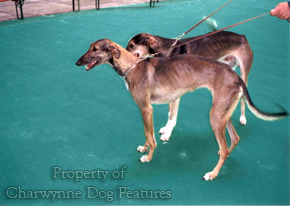 mina of the pure Borzoi in the long pursuits on the plains. Lurcher breeders will identify with his words ‘with a lot of sense’; a fast dog with no brains is not an ideal hunting companion.
mina of the pure Borzoi in the long pursuits on the plains. Lurcher breeders will identify with his words ‘with a lot of sense’; a fast dog with no brains is not an ideal hunting companion.
Freeman Lloyd likened a day’s coyote hunting with antelope coursing in Africa and an open ‘go as you please’ coursing match in Australia. He mentioned the ‘Strathdoon Dingo Killer’, a blend of Borzoi and Deerhound with the tried and tested Kangaroo Hound. The latter was described by him as ‘a large Greyhound, having in many cases the coat of the Deerhound’. The kangaroo can be a formidable quarry, capable of disembowelling a hound with its immensely powerful hindfeet. His words emphasise the endless need to embrace terrain, climate and quarry in developing an efficient hunting dog, especially a longdog, even from a blend of well-tried types. 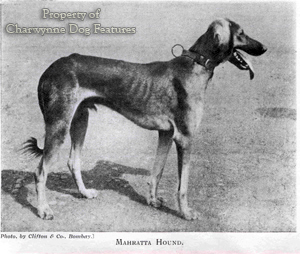
In his book Lurchers and Longdogs, Ted Walsh mentions the Nebraska coyote hound, 29½" at the shoulder and weighing 90lbs. He quotes from a Minnesota report on the American houndman which states: 'He merely breeds one good hound to another regardless of background...the basis of the American lurcher is the greyhound crossed first with the Scottish deerhound; secondarily with the Irish Wolfhound and Borzoi; rarely with the whippet or saluki. This breeding pattern may be explained by considering the game coursed in North America, the hare (jack rabbit), red fox and coyote.' This account sets out the use of 'cold blood' or coursing greyhound on hare, a rougher-coated hound on red fox and the emergence of an Americ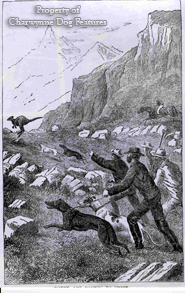 an Coyote Hound, 75 to 100lbs, with a Deerhound coat. But it stresses that no kennel there was raising either Deerhounds or Borzois primarily for hunting. The Whippet was recommended for the cotton-tail rabbit, lacking the stamina for the jack rabbit. In Australia, their lurcher-like running dogs are a type described either as Staghounds, Kangaroo Dogs or Bush Greyhounds. Their similarity illustrates how function dictates form.
an Coyote Hound, 75 to 100lbs, with a Deerhound coat. But it stresses that no kennel there was raising either Deerhounds or Borzois primarily for hunting. The Whippet was recommended for the cotton-tail rabbit, lacking the stamina for the jack rabbit. In Australia, their lurcher-like running dogs are a type described either as Staghounds, Kangaroo Dogs or Bush Greyhounds. Their similarity illustrates how function dictates form.
Australian hunters have made good use of imported longdog blood, blending the blood of Salukis, Borzois and Scottish Deerhounds with the long-utilised Greyhound source. Kangaroo Dogs from the famous Wheatbelt line have strong Greyhound blood; Staghounds from the same line have clear Saluki blood, intended to improve their heat tolerance and long distance sprinting capability. The Wheatbelt Kangaroo Dogs remind me of the outstanding longdogs once bred by Nuttall of Clitheroe, who, I believe, used a purebred Deerhound sire to a retired track or coursing Greyhound dam. Brian Plummer has described them as ‘truly magnificent animals…leg weakness, a common fault in deerhounds and in first-cross deerhound hybrids was practically unknown in these kennels, partly due to the judicious selection of both sire and dam by Nuttall and partly due to careful feeding of the whelps at his kennels.’ Those words sum up the key ingredients for the successful breeding of any longdog: the selection of breeding stock and wise rearing. May the future be kind to them, wherever in the world they are favoured.